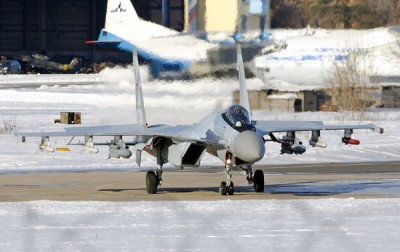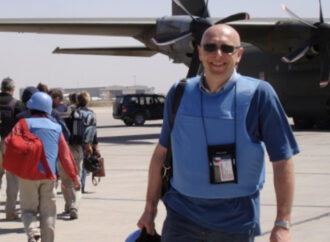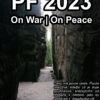
Su-35S of the Russian_Air Force; Photo via Wikimedia Commons
Russia has been undergoing a major military transformation aiming to develop a truly modern Army with integrated command and control, capable of modern-style joint operations in a wide spectrum of theatres. Moreover, the present Russian leadership, dedicated to restore Russia´s great power status considers military might to be a corner stone of the rise of Russia. One of the key requirements on modern armies is a capability to wage an effective coercive air-campaign. How is contemporary Russia ready to wage such campaign against Ukraine and would it be able to compel the Ukrainian leadership to its will by the power of its Air-Force?
The Russian military establishment finds itself amidst a key modernization period, which aims to definitively transform the army´s structure and capabilities from the Soviet heritage into a modern force. In his 2012 election campaign President Vladimir Putin announced his plans to start an unprecedented program to develop the Armed Forces and modernize the defense industrial complex. The State Armament Program 2020 contains a comprehensive set of steps to transform the Russian military.
Future capabilities of the country´s military will from a large part derive from the ability of the government to meet implementation requirements of 2020 Strategic Armament Program, a comprehensive program for modernization of organization and equipment. In total, as much as 70% of the armory should be modernized by 2020, giving the forces a “new look” and new operational possibilities that will allow Russia to protect its national interests and be a guarantor of regional stability. The ambitiousness of the plan demonstrates the Russian regime´s emphasis on having a well-functioning and equipped military – one that would be too expensive only for the traditional parades on the Red Square.
Overall, successful implementation of the ambitious SAP will be largely derived from ability of the government to generate enough income, and from its will to allocate it to defense spending. Between 2011 and 2012, in the first SAP implementation stage, Russian real defense spending increased by 17.2%, the second largest growth in the world (exceeded only by China).
Following the Clausewitzian logic that political objectives determine military actions, the transformation is generally understood as “a strategy designed purposefully to achieve a cogent vision of the future”. Missions that the military should be able to perform, are described in 2010 Military Doctrine of the Russian Federation. The document articulates the “Russian Federation’s adherence to the utilization of political, diplomatic, legal, economic, environmental, informational, military, and other instruments for the protection of the national interests of the Russian Federation.” The Armed Forces should maintain a “high level of readiness for combat utilization,” as well as the capability for a “timely deployment in potentially dangerous strategic salients.” Furthermore, the Doctrine stresses the importance of air force in the modern warfare, emphasizing the “air defence of the Russian Federation’s most important military facilities and readiness to rebuff strikes by means of air and space attack.”
Command and Logistics
Russian redesigned division of command districts with integrated and technologically modernized equipment would enable a relatively effective coordination of the overall campaign. West Joint Strategic Command (WJSC) with HQ in Saint Petersburg establishes control over the district’s ground forces, air-force and air-defense units. The Western Military District includes the units that would have been mobilized for action in the European theater and nearby waters; the Moscow and Leningrad military districts and the Northern and Baltic Fleets. In addition to Command West, Command South with HQ in Rostov on Don would play a crucial role in conducting operations against Ukraine from the strategically essential port of Sevastopol, where the Russian Black Sea Fleet is based. Authority over all military forces is exercised by the HQUSC in Moscow.
Air-bases
In the Southern Military District, relevant for a campaign against Ukraine, Russia has four major air-force bases in close proximity to the Ukrainian border. The well-tested Millerovo air-base in the area of Rostov, moving southward along the border, Central air-base near the economically important Russian city Rostov on Don with the adjacent Kushchevskaya air-base would be able to continuously support a significant number of sorties. Taganrog and Primorsko-Akhtarsk air-bases are located at the Black Sea coast to provide support from South. Further, three additional bases could be easily used to support the Russian air-campaign; Krymsk, Korenovsk and Morozovsk.
The Western Military District accommodates a network of bases in Karelinian, Leningrad and Murmansk Areas. All of them have recently tested high combat readiness. Pilots from the air-bases in the Western Military District are among the best-trained in the country, with over 50,000 hours combined, or 140 hours per pilot, spent in the air in 2013, mostly in the cockpit of fighter aircraft MiG 29 or MiG 31, but also on fighter-bombers Su-34 and Su 27. Finally, the aforementioned bases have a sufficient infrastructure to base and provide support for a noticeable number of Russian fighter aircrafts, bombers, ISR vehicles, and cargo and airlift aircrafts and to sustain a high rate of sorties.
Communication
Effective communication, coordination, target locating, intelligence gathering and overview of the Ukrainian forces movements would be vital for the effectiveness of the Russian campaign from the early stages. This is for two principal reasons; geographically, Ukrainian territory is fairly extensive and variable; operationally, Russia would conduct its campaign in several directions and from a number of distant bases. In this mission, Russia could rely on its large, multi-purpose network of 58 satellites.
The bulk of Russian Military communication is enabled by two key systems, Meridian and Raduga. The fourth series of Meridian military satellites has been launched to a high orbit of 24,700 miles, enabling it to cover regions out of the reach of many traditional spacecraft.In cooperation with Raduga military System located in Geostationary orbit for its mission in providing communications for the Russian military, Russia is expected to have a 24/7 reliable communication coverage over the whole theater of operations. This should give it a significant advantage in conducting the campaign against Ukraine.
Furthermore, Russian early-warning system should provide sufficient protection for Russian strategic assets and cities against potential Ukrainian retaliatory strikes. S-400 and S-500 air defense systems and short-range surface-to-air Pantsir-S1 missiles can use data from Oko-class early warning satellites designed to detect missile launches with an infrared telescope in complementation with early warning radars Voronezh in Kaliningrad and Daryal. To counter vulnerability of the space-based systems (even though very doubtful given the Ukrainian obsolete inventory of missiles), Russia can facilitate communication and early warning by operating telecommunications networks, radio-electronic reconnaissance aircrafts, and Airborne Warning and Control System (AWACS) with A-50 and A-50U planes.
Targeting
Strategically effective targeting which contributes to achievement of set political objectives by destruction of those targets can be – similarly as in the operation Allied Force – divided into three consequent phases. The phases are inspired by the Warden´s system of concentric rings, each representing Ukraine´s centers of gravity, which if properly attacked, might make continuation in war prohibitively costly for the Ukrainian government. However, for it is plausible to assume that the population ring would be left aside.
Strategically the approach towards target selection would likely not be dramatically different from that of the Operation Allied Force in 1999. The selection and gradual broadening of targets during the NATO 1999 campaign set a standard for an escalatory, compellence air-campaign; it allowed for increase in cost for not compelling, and promised to keep costs low if compellence comes quickly.
Phase I would include targets associated with air defenses located in proximity to the Russian-Ukrainian border. Phase II would expand the types, number, and distance of targets; it would reach to strategic sites further inland to prevent forces mobility and reinforcement, and to minimize their combat readiness. . In the final phase III, the air operations would expand against a wide range of high-value military and political targets throughout Ukraine, including key political leadership buildings. Center of gravity would shift to areas around Kiev and to Kiev itself.
Russian Comparative Advantage
All of the Russian SU class fighter aircrafts can engage aerial threats as well as ground targets by deploying onboard air-to-air and air-to-surface guided/unguided weapons. They can carry a considerable payload (in case of SU-30 up to 8 tons) and be fitted with a wide range of anti-surface weaponry including air-to-ground missiles, freefall and retarded aerial bombs or cluster bombs.
Furthermore, ISR missions to seek dispersed Ukrainian anti-aircraft batteries could be provided by SU-24 in cooperation with modified MiG-25s. A50s would be able to take care of airborne early warning. Armed with precision guided munition coordinated from the modernized Western Command, and relying on data from a network of satellites, Russian strikes would have a serious lethal potential. A part of the lethality of the Russian forces might be traded for survivability if the pilots would choose to flight above 15,000 feet to avoid Ukrainian AAA.
To further disrupt Ukrainian ability to defend itself, Russia might use its newly developed, yet infant and untested, offensive cyber capabilities. Russia’s predominantly defensive cyber-strategy acknowledges a potential offensive role in disrupting adversary information systems, including by introducing harmful software defending Russian own communications and command. In contrast, Ukraine lags behind and has only recently stated its goal to start developing cyber warfare capabilities and its command and control systems thus could be vulnerable.
The Ukraine´s military is equipped with obsolete, often old Soviet equipment, that is underperforming and extremely-well known to the Russian military. Additionally, corruption, low wages and poor treatment of soldiers leads to low morale among the Ukrainian military personnel. Overall, Russia would likely face an inferior enemy and have a considerable advantage in all preponderance, technology and force employment.
Ukrainian air defense would rely on several systems, none of them likely to be individually or in concert capable of performing a fully effective access denial mission against Russian aircrafts. Initially, the bulk of defense would rest on R-60 surface-to-air missiles which should not be, due to its technological inferiority, a large obstacle to Russian fighters. Secondly, the Ukrainians would use their S-200V „Vega“ high-altitude surface-to-air missile system, also designed to defend large areas from bomber attack or other strategic aircrafts. The original design is from the 1970s and Russian pilots and commanders are very familiar with the systems´ advantages and flaws as it has been a part of their armory as well.
Finally, more lethal Air Defense Missile Systems S-300PS are on a lower readiness mode (in a normal political situation), designated primarily to protect the most important governmental buildings and military installations. With their limited range between 5 and 75 km, it is unlikely that a significant number of S300PSs would be ready to engage Russian aircrafts in case of a rapid and surprising campaign. In short, the current structure of the Ukrainian National Military Establishment is no longer able to perform the entire scope of tasks within the area of National Security and Defense.
Nevertheless, the Russian advantage in skills and technology would bring decisive results only after a while and at a relatively high cost.
Limits of the Campaign
The Russian modernized structure of command a wide network of air-bases in the proximity to the Ukrainian border would allow the Russian air-force to engage a high number of targets. Taking into account traditional factors such as numerical preponderance, technological advantage, and going beyondthe gross “state of the art”, including also how the forces are actually deployed, influenced by training and other factors, indicates how the campaign would unfold.
Russia would relatively quickly and with a low loss ratio win superiority over the Dnepropetrovsk Area and turn its attention to strategically critical Sevastopol. Ukrainian resistance would bring a series of heavy air-to-surface and air-to-air combats and the conflict would quickly escalate. Russian forces would eventually prevail due to a number of factors interacting non-lineary. Whether Russia would be willing to escalate its campaign and move strikes further towards Kiev would largely depend on its willingness to accept losses at the peak of the Ukrainian defensive efforts. However, despite Russian dominance over the Ukrainian Air Space and destruction of most of the designated military and political targets, Russia would not be able to gain an absolute control. The vast Ukrainian territory and its large population would present a constant danger to Russian air-forces.
The coercive power of air strikes would inevitably hit in its limits. Coercion by punishment (inflicting costs on civilians) has not proven to be effective. Populations are relatively easily protectable and political leadership is not likely, especially in extreme situations, to change its decisions. Furthermore, if the campaign is aimed directly at key leaderships and telecommunication facilities, a possibility of it breaking the government´s resistance is improbable; the leadership may easily conceal and tracking it is extremely difficult, if not impossible. So: “Can air power alone do the job? The answer is no.” (Robert A. Pape)
41 comments









41 Comments
OMFG
6. 3. 2014, 23:03MiG-31 ako fighter a Su-27 ako fighter-bomber? System S-500 je uz v sluzbe? Ukrajina a ASAT capabilities? R-60 ako strela zem-vzduch?
…
REPLYIvo
6. 3. 2014, 23:16Thanks for this great article with an impressive overview of Russian military capabilities and their current force disposition. I would not have patience to look it up myself. Just a few remarks to conclusions:
First, I think that the article slightly underestimates the ability of Ukraine armed forces to inflict casualties to Russian Air Force. We should bear in mind that Russian Air Force lost about 7 aircrafts in Georgian war in less than a week. The AA systems Buk-M1, which were responsible for more than 50% of the Russian losses, were supervised by UKRAIAN instructors (weapon systems were sold to Georgia from Ukraine).
Second, the article implies the air campaign started by Russian Air Force would follow more or less the same pattern as that of the US Air Force in Kosovo air campaign – sequential.
I do not think that is the probable COA. If anything it would be simultaneous, and not only for the Russian Air Force. Unlike in Kosovo, Russian would not have the luxury of time. Therefore, the campaign would have to be joint with Air Forces and Ground Forces working hand in hand from the first moment.
Waging a joint campaign was the Achilles Heel during the war in Georgia in 2008. And there are not any indications that Russians made any significant improvements in this field. Unfortunately for them, the joint campaign would be the necessary requirement to achieve the operational objective „protection of the Russian minority in eastern Ukraine with the option of future annexation“.
Bombing the Ukraine population and its armed forces to submission would not further Russian operational goals a single inch…
REPLYTomas.Kolar@Ivo
7. 3. 2014, 1:16I’d expect that the air campaign to start few days before any ground attack. That would give a moment of surprise to Russians as it is much easier to keep preparation for it in secret. Ground forces could move few days afterwards, and without concerns of serious air attacks. But I’m not an expert, of course.
Nevertheless, I agree completely with the idea that air strike on its alone won’t make that job for Russians.
REPLYh-cz@Ivo
7. 3. 2014, 9:53Following the joint efforts strand: Joint capability is only achieved at the peak of synergy among the participating branches of the Armed Forces. The key enablers are the most valued (and the most costly) assets, such as joint terminal attack controllers (troops dimension) or joint situational awareness (operational dimension).The underlying infrastructure requires coherency across training, procedures, communication means and last but not least also a will and culture prepared to delegate elements of command to other bodies.
With limited insight into modern Russia, I see very few indicators that these enablers would be fielded in other than sporadic fashion.
In other words, Russian Armed Forces does possess many advanced capabilities, but most of them are stovepiped into specific branches. This puts a tremendous burden on planning staffs and limits their flexibility to adapt to a developing situation; but such flexibility is only required if the counterpart is not stunned (as Ukraine is ATT) or limited to political aspects only (as are the nations supporting Ukraine).
Having said this, one has to appreciate Russia’s willingness to deploy the blunt power and hope to succeed by exploiting the system-based and culture-based weaknesses of the West.
REPLYIvo
7. 3. 2014, 19:57Ad Tomáš Kolář)
From a strictly military point of view your conclusion seems right. But campaigns are not just about what is the most efficient military solution.
Take the Falklands War as an example. The battle of Goose Green was one of the bloodiest engagements of the war – it was also the first major one and the British forces were not fully prepared for it yet. In spite of that the British Army was forced to fight it so soon to MAKE DIPLOMATIC SOLUTION IMPOSSIBLE.
Second example is from Yom Kippur War. President Assad initiated the hostilities knowing that he is GOING TO LOSE MILITARILY against Israel and hoping for a better settlements mediated by the USA later.
Therefore, I do not think that Russians would have the luxury of gradual attrition of Ukraine air defence and air force and then initiating ground offensive. What if USA declares „No flight zone“ over Ukraine second day of the conflict? Fighting ground war with Ukraine without air support on the hostile territory would be pretty tight affair…
Ad h-cz)
REPLYOne can appreciate the blunt power of Russia, but in the same time he has to admit that the sole reason Russians are so eager to utilize it is that without it they are left completely empty handed. They do not possess any soft power as was proven by the complete unattractiveness of the prosed Euro-Asiatic Union, which was immediately rejected by Ukraine (and we already know the results)…
Tomas.Kolar@Ivo
8. 3. 2014, 13:50Thank you for clarification, that really make sense.
REPLYh-cz@Ivo
10. 3. 2014, 10:20ad Ivo)
heh, yeah, but where is the cost effectivness? why should Russians care about the soft power means, if their opponents are (percieved as) utterly unable to respond to hard power projection.
I would be pleased should this backfire and should the soft means catch up upon them; but still …
Thinking again about my previous comment, I believe that if one is to plan for confrontation with Russia, one should exploit their stovepiping and pre-planning:
REPLYfor stovepiping – as the WW2 divisions often attacked at the boundaries of the allies or allied units, at the current battlefield, the centres of gravity should be designed in such a fashion to disconnect land from air, infantry from artillery, troops from medevac, operational logistics from the front units; in other words to degrade any sign of joint efforts.
for pre-planning: as indicated above, Russians tend to address this deficiency by careful planning. I assess they must be rather slow to adopt to a developing situation…
Anonym
7. 3. 2014, 20:40Off topic
Vzhledem k tomu,jak se vláda ČR(až na čestné vyjímky) a EU k problému postavili.Tak tohle je asi jediné co můžeme zatím udělat.Doufám že tam někoho z vás uvidím.
V sobotu 8. března 2014 v 17h se na řadě míst České republiky bude konat koordinovaná demonstrace „ZA VAŠI I NAŠI SVOBODU“.
Účastníci této akce nesouhlasí s okupací Krymu ruskými vojenskými jednotkami. Přejí si nastolení demokratického řádu na celé Ukrajině!
http://www.ukrajinci.cz/cs/aktuality/detail/za-vasi-i-nasi-svobodu-ne-ruske-okupaci-ukrajiny-8314-v-17h-v-praze/
REPLYIgnác Opušťák
7. 3. 2014, 22:54Rusko se nejspíše poučilo z chaosu při tažení v roce 2008, už podle použité lehké a nové techniky, výstroje a výzbroje vojáků, je vidět, že nenasadili nejbližší jednotky odvedenců, ale možná i plně profesionální jednotky, možná určené pro podobné operace, ze záběrů v mediích je vidět, že jsou disciplinovanější než v dřívějších letech. Těžká pásová technika, zatím, není nikde vidět, snad k vidění nebude vůbec. Na kolik pravidelná ruská armáda používá pro každého druhého vojáka radiostanici a kolimátor na útočných puškách nevím, ale moc toho asi nebude.
Pokud tam chtějí rusové „existovat“ déle tak si snad nebudou moci dovolit získání území metodou „humanitárního bombardování“ ukrajinci by jim zatopili, tak jako iráčané a afgánci ve svých zemích alianci. …z bídou budou rádi pokud jim zůstane základna na krymu.
Co se týče výzbroje, možná by stálo za to zmínit, že má rusko strategické nosiče střel s plochou dráhou letu (s konvenčními hlavicemi) naváděné jak inerciálně tak pomocí satelitní navigace. S takovými cíly se obtížněji bojuje, ale i přes to má Ukrajina ve výzbroji GBAD systémy, které to v omezené míře umí, hlavní je kvalita výcviku obsluh. Autor tu zmiňuje i systém S 200 Vega, ten je určen především pro boj s nemanevrujícími cíly – bombardéry (stíhací letouny dokáží tuto raketu vymanevrovat), sice má velký daleký dosah, hlavní nevýhodou systému je nesnadné a dlouhé provedení manevru na jiné stanoviště, jen na okraj ukrajincům se podařilo kdysi při ostrých střelbách omylem sestřelit dopravní letoun, právě tímto systémem, nad černým mořem. Pro ochranu vlastní vojsk mají dostatečné krytí pomocí mobilních systémů KUB, BUK (dokonce minimálně jeden komplet původně vyrobený pro ČSSR), TOR, OSA, Tunguska, Strela S 10 u těchto systémů i systémů S 300 PS a S 300 PT (zařazenývh v objektové obraně) se hodně uplatňuje taktika „vystřel a uteč.“
REPLYVe vzduchu na tom budou o dost hůře, jejich stíhačky Mig 29 a Su 27 mají jen v omezené míře modernizované původní radiolokátory. Starší verze řízených střel. Rusové naproti tomu mají ve výzbroji letouny schopné současně působit na více cílů, za pomoci radiolokátorů PESA, k tomu velkou výhodu v podpoře letounů A 50 a novějších střelách vzduch – vzduch. Investovali i do lepších systémů ECM v případě nových stíhacích bombarderů SU 30, 34. V současné době zavádějí do výzbroje pár kusů SU 35 S velmi výkonnými IR čidly a radarem IRBIS – některé zdroje uvádějí dosah s odraznou plochou typu F 22 až 50 námořních mil, je to sice nepravděpodobné, ale už v případě konfliktu s Gruzií jim vytrhli trn z paty Su 34 v boji proti PVO (odvolali je z vojskových zkoušek přímo do boje).
Autor tu zmiňuje střely R 60, předpokládám, že označení SAM je překlep – vzhledem k tomu, co naleznu na přiloženém odkaze (v kategorii střel R 60 má Ukrajina i o třídu výkonnější rakety s IR hlavicemi R 73 a R 27T)
V případě konfliktu má dnes Rusko výhodu v zavedení systémů efektivně použitelných v noci, daří se jim do výzbroje zařadit vrtulníky Ka 52 i s novým systémem aktivní ochrany proti IR střelám, vrtulníky Mi 35 M vybavené systémy FLIR a NVG.
Pro provádění operací SEAD mají obě strany k dispozici protiradiolokační střely CH 58 (kdysi ve výzbroji i českých Su 22M4), rusové pak novější a výkonnější CH 31. V tomto případě se může projevit výhoda případného použití novějších systémů GBAD na ruské straně, novější verze BUK M2, Pantsir S1 a S 300 a S 400 si totiž poradí i s protiradiolokačními raketami.
Otázkou je, zda dokáží rusové pokrýt efektivně větší prostor, než je Gruzie, aniž by riskovali přesun techniky z jiných oblastí země.
Ivo@Ignác Opušťák
8. 3. 2014, 8:47„Rusko se nejspíše poučilo z chaosu při tažení v roce 2008, už podle použité lehké a nové techniky, výstroje a výzbroje vojáků, je vidět, že nenasadili nejbližší jednotky odvedenců, ale možná i plně profesionální jednotky, možná určené pro podobné operace, ze záběrů v mediích je vidět, že jsou disciplinovanější než v dřívějších letech. Těžká pásová technika, zatím, není nikde vidět, snad k vidění nebude vůbec. Na kolik pravidelná ruská armáda používá pro každého druhého vojáka radiostanici a kolimátor na útočných puškách nevím, ale moc toho asi nebude.“
Jedná se totiž o vojáky 22. brigády rychlého nasazení z Rostova nad Donem a 25. pluku speciálních sil ze Stavroplu. O celkové kvalitě ruských ozbrojených sil vypovídají tito vojáci asi tak jako operátoři 601. SkSS o kvalitě vojáků v AČR…
REPLYIgnác Opušťák@Ivo
8. 3. 2014, 10:52Tak že něco jako STS Chvojkovice Brod, jak dlouho se na ten výlet asi připravovali?
REPLYptaksedivak@Ivo
8. 3. 2014, 21:41Hovori se i o praporu MVD z Cecny – ucastnil se i kampane v roce 2008. Pokud by byly na Krym vyslany opravdu nejake ruske jednotky, prichazi v uvahu jedine kontraktniky .
REPLYSpis bych byl znepokojen stale vetsim nasazenim kozackych esaulu. Obavam se, ze neprisli jen s nagajkami…Bude velmi obtizne je udrzet na uzde.